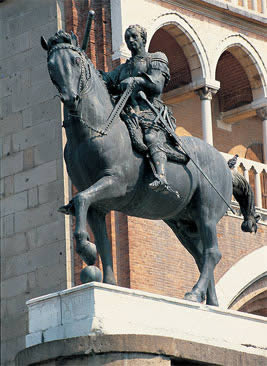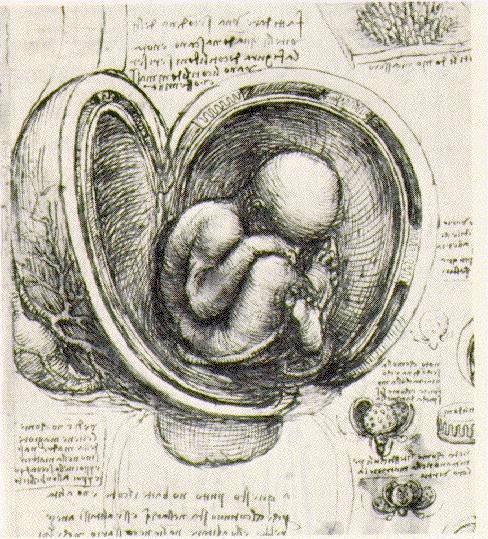Context
The 15th Century
Humanism
Humanist philosophy became increasingly popular at the end of the fifteenth century. Scholars expanded their studies and they focused ever-more on accumulating knowledge, especially about classical antiquity. Thinkers strove to become "Renaissance men" in the true sense of the word as they explored many avenues of study. This quest for knowledge began by exploring the legacy of ancient Greeks and Romans, including the writings of Plato, Socrates, Aristotle, Ovid, and others, whose texts were circulating once again thanks to the invention of moveable type by Johannes Gutenberg (14th century-1468). Before moveable type, printers had to carve entire pages or sections of pages out of a single block, which made the production of books time-consuming and expensive. Gutenberg's moveable type on his own and others' active printing presses meant that texts could now be produced quickly and efficiently, which led to a significant rise in the availability of affordable books and tracts. This printing revolution also fostered a slow rise in literacy.
Personal achievement and civic responsibility were central tenets of humanist ideals. With this mindset, artists started being known and appreciated as individuals, which created an environment in which major artists such as Leonardo da Vinci and Michelangelo were celebrated on the same level as rock stars today. Achieving quality and excelling through hard work thus became moral imperatives.
There were constant fluctuations in politics and the economy during this period; nevertheless, the growing middle class also embraced the humanist spirit. They sought wealth and power, and celebrated (and advertised) their accomplishments by commissioning portraits and other forms of self-promoting patronage as acts of civil pride and duty.
The Medici family was at the fore of such initiatives. They patronized the arts on a larger scale than had ever been seen especially in their hometown of Florence. After making their money through banking and rising through the middle to the upper class, the Medici commissioned seemingly countless works of art that embraced and expressed humanist ideals. This is especially critical at this time because the Catholic Church was trying to keep traction and stay relevant during a time of intellectual expansion. The humanist movement impacted Catholicism in both spiritual and political arenas.
16th Century: The High Renaissance
Rational humanist ideals culminated in the High Renaissance, which is also the period that precedes Mannerism and the Baroque era. The phases of the Renaissance mirror the phases of ancient Greek styles of art: as the Medieval era was marked by geometric and archaic phases that culminated in the Gothic and Proto-Renaissance, ancient Greek art similarly moved through geometric and archaic phases to arrive at a late classical style marked by order, rationality, and proportion, like the Renaissance. Moreover, both the ancient Greeks and Renaissance artists would make way for later styles marked by spectacle and movement; in ancient times, the dramatic Hellenistic style mirrored the theatricality of the Mannerist and seventeenth-century Baroque periods that followed the Renaissance.
Some of the best known artists today were products of the High Renaissance, including Leonardo da Vinci, Michelangelo, Raphael, and others.
Protestant Reformation
The Protestant Reformation was a major turning point in the history of the Catholic Church. The German monk and theologian Martin Luther (1483-1546) and the French theologian John Calvin (1509-1564) objected to the abuse of power and bureaucracy of the Catholic Church, and pushed for changes in religious practices. The seminal moment came when Martin Luther composed his "Disputation on the Power and Efficacy of Indulgences," commonly known as his 95 Theses, which he may have nailed to the Castle Church door in Wittenberg on October 31, 1517. More significantly, the Theses were printed and distributed using Gutenberg's new moveable type, so word quickly spread that people were starting to challenge some Catholic practices. Luther and Calvin especially objected to the sale of indulgences, in which a person could be absolved of sin by paying a fee and receiving an indulgence. They also questioned whether some church rituals were symbolic or magical. For instance, in Protestant belief (the word "Protestant" literally derives from the fact that people protested some beliefs) holds that the rite of the Eucharist is a symbolic act, since the wine and bread symbolize the blood and flesh of Christ, whereas Catholic belief holds that the wine and bread become the blood and flesh of Christ. Calvin and Luther also objected to the accumulation of wealth by church officials and the rampant nepotism in church appointments, in which men in power appointed friends and family to high posts over those who might have been better qualified.
Below you will find a series of videos to introduce you to this important moment in the history of Christianity:
Following the Reformation, Pope Paul III sought to revitalize the image of the Roman Catholic Church through numerous commissions and thereby sparked the Counter-Reformation.
Counter-Reformation
Pope Paul III (1468-1549) convened the Council of Trent, which met first in 1545. The Council was composed of cardinals, archbishops, bishops, abbots, and theologians, and they continued meeting at intervals through 1563 to discuss issues of Church doctrine and to consider the reforms described by Luther and Calvin. However, the Council changed little in actual church practice. At the same time, the Catholic Church continued to commission works of art to bolster and reinforce the visibility and validity of the Catholic faith. Much of the imagery from the Counter-Reformation focuses on the inevitable fate of those who leave the Church, according to those who commissioned the work. This explains why the image of Christ shifts from Christ as a shepherd in the Proto-Renaissance and Renaissance to Christ as a stern judge during this period, for instance.
Florence
During the High Renaissance, Florence was a major hub of artistic innovation in Italy. The economy and artistic life of Florence was supported largely by the Medici family, who commissioned both religious and secular images. Catholic churches in this city-state were also wealthy and had the means to commission work from the most famous artists of the day. During a time when city-states were constantly vying for power, Florentines considered themselves the constant underdog, despite their wealth and prosperity. They used the biblical figure of David as their mascot, and likened their trials to David's triumph over the giant Goliath in the Old Testament. David also went on to rule as a good and just king, and the Medici, who essentially ruled Florence, hoped that others would draw the same parallel with their efforts.
Giorgio Vasari
Vasari (1511-1574) is often referred to as the father of art history because he was the first to write an account of the history of art through his biographies in the Lives of the Artists. Published first in 1550 and again in 1568, the book fostered a long-standing fascination with Italian Renaissance artists.
Renaissance Themes
Several themes appear in works of art throughout the High Renaissance.
Classical themes: In the midst of humanism and with a desire to learn about classical philosophy and thought, artists looked back to classical images of ancient Greece and Rome in an effort to recapture the naturalism of these works. This is especially apparent in Italy, where wealthy patrons had the means and interest to support artists' pursuits of this style. Images of nudes, pagan mythological narratives, and a general interest in proportion and naturalism are all aspects of these themes.
Religious themes: The Catholic Church sought to maintain its presence and relevance through commissioned works of art even as the political climate shifted and people became increasingly interested in regional histories and vernacular (that is, non-religious) subjects. This was especially important during a period when disease threatened and the economy could fluxuate wildly. Artists like Michelangelo and Botticelli were tapped to create works in this religious and political climate.
Secular images: The growing middle class looked to capture their likenesses and immortalize their progress through portraiture. They also desired landscape and still-life paintings to beautify their homes. Thus there is a surge of secular images to meet this growing demand.
Perspective: Leon Battista Alberti (1404-1472) recorded ideas about perspective and illusion in his 1435 Treatise: On Painting. In this seminal work in the history of art, he discusses how to work with linear perspective and capture aerial (atmospheric) perspective. Aerial or atmospheric perspective describes the phenomenon in which forms are less distinct the deeper they are in space.
Renaissance Sculpture
Florence Cathedral Baptistery
There were many innovations in sculpture throughout the Renaissance. The competition for the doors of the Florence Cathedral Baptistery in 1401 sums up the progression of this art form and also illustrates the nature of competition amongst artists during this time. A competition was held in 1401 to decide who would be awarded the commission to decorate the east doors of the Baptistery, which faces Florence Cathedral and is only a few steps away from it. This was a major commission that would take many years to complete and would require a huge investment from those paying for the doors, so this was an opportunity for the artist who won the commission to make a name fof himself. The project was sponsored by the Arte Di Calimala (the wool merchants guild), who decided that each entry would consist of a relief panel depicting the biblical story of the sacrifice of Isaac. Each artist needed to fit their composition into a Gothic quatrofoil frame (a design made up of four lobes and four points) to match the format of the existing doors decorating the south-facing entrance to the Bapitstery. Seven semifinalists and two finalists were chosen. The semifinalists, Filippo Brunelleschi (1377-1446) and Lorenzo Ghiberti (c. 1378-1455), represented two facets of Renaissance thought. The collision of these two men's personalities and their subsequent contentious relationship is one of the most intriguing stories of this period.
Here is the design each artist submitted for consideration in the competition:
 |
|
| Filipo Brunelleschi, Sacrifice of Isaac |
Lorenzo Ghiberti, Sacrifice of Isaac |
|
|
Whose panel would you have chosen?
Ghiberti won the commission when he was only 21 years old and, ironically, and spent the next 21 years working on these doors! The final doors contained twenty-eight panels and each panel measured 20.5 x 17.75 inches. Twenty panels illustrated scenes from the New Testament and the bottom eight show the four evangelists and four church fathers.
Following the celebrated completion of the first set of doors, Ghiberti was commissioned to create a second set of doors for the third and final opening to the Baptistery. (Knowing how to refer to each set of doors can be a little confusing because Ghiberti's first set of doors was created for the east-facing entrance but were then moved to the north-facing entrance once the second set was complete and installed on the east side.) The second set is commonly known as the Gates of Paradise and they were produced in 1425 to 1452. The doors got their name when Michelangelo reportedly stated that they were so beautiful that they could act as the gates of Paradise itself. This time, ten panels show Old Testament themes.
Instead of working in nearly full relief, as with the first set of doors, Ghiberti made much larger panels that were created using a much lower relief. He also was not working within the decorative and artificial quatrefoil frame so was able to create panels that incorporate a much deeper sense of space. Each panel is composed with its own vanishing point and one-point perspective, which gave him more space to explore the narratives in more detail. Ghiberti's knowledge of classical antiquity was also evident, and he was known to have collected classical sculpture, bronzes, and coins.
About these doors, Ghiberti stated,
I strove to imitate nature as closely as I could and with all the perspective I could produce (to have) excellent compositions rich with many figures. In some scenes I placed about a hundred figures, in some less and in some more….There were ten stories, all (sunk) into frames because the eye from a distance measures and interprets the scenes in such a way that they appear round. The scenes are in the lowest relief and the figures are seen in the planes. Those that are near appear large, those in the distance small, as they do in reality (quoted from Kleiner 427).
Donatello (c. 1386-1466) was famous for his relief sculptures as well as sculpture in the round. The Medici family and important leaders in religious orders were frequent patrons of his work.
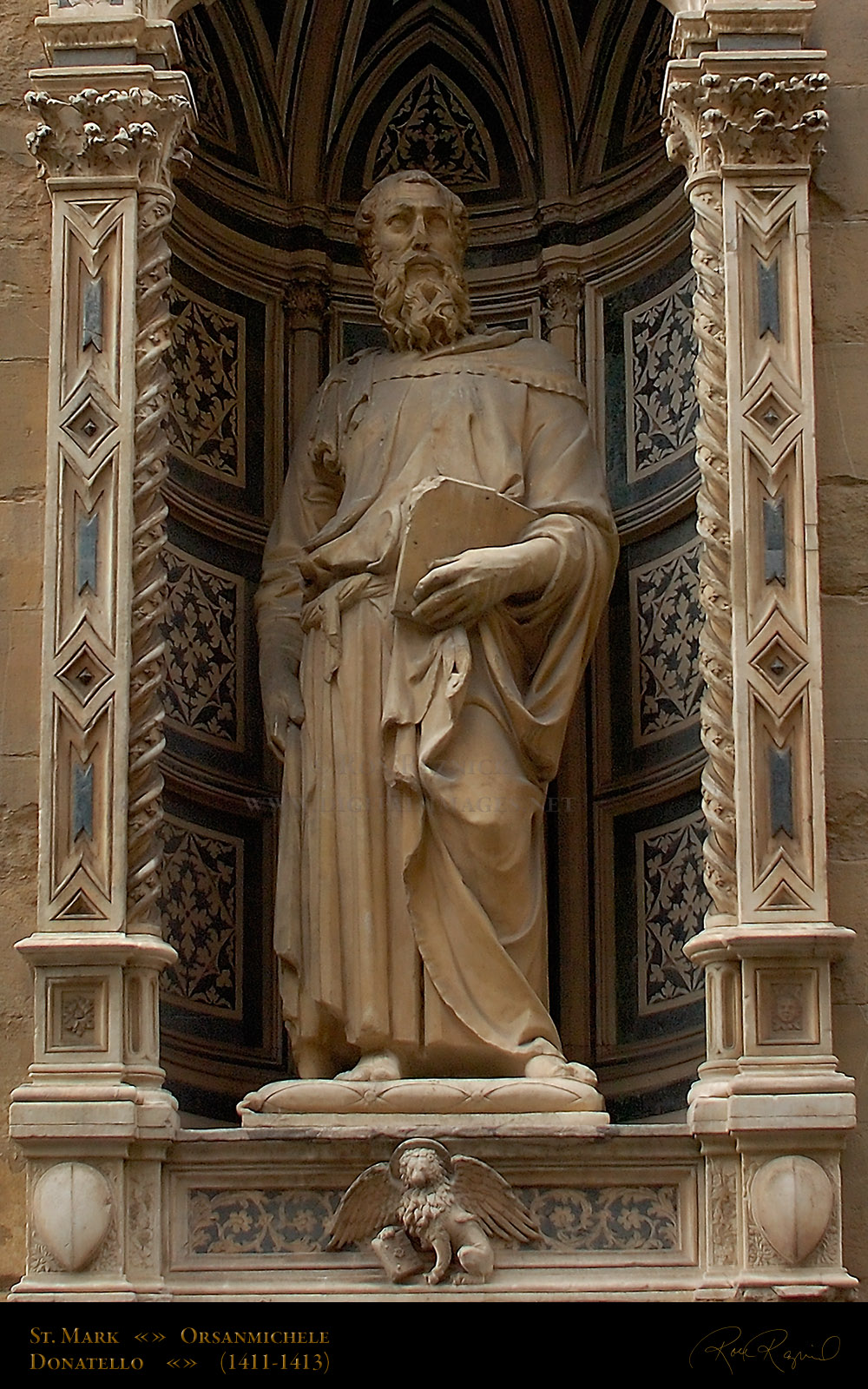
Donatello, Saint Mark, Orsanmichele, Florence, 1413
Donatello was one of nine sculptors commissioned to fill fourteen niches on the Florentine church of Orsanmichele. Each niche was assigned to one of the major guilds in Florence, who were required to commission a statue of the guild's patron saint. Donatello created his larger-than-life-sized sculpture of Saint Mark for the linen weavers guild, which might account for the saint's lively drapery.
As the saint’s body moves, his robes move and shift with him, rather than falling in arbitrary, decorative folds. It was the first such sculpture where the drapery did not conceal, but rather accentuated the movement of the arms, legs, shoulders, and hips. The sculpted figure asserts its independence as he seems to move within and away from the confining niche.
Between 1406 and 1423, many of the niches were filled with statues by Ghiberti, Donatello, Nanni di Banco, and others. This sculpture demonstrates the incorporation of Classical Greek and Roman principles. It also is a step toward depicting motion by recognizing the principle of weight shift.
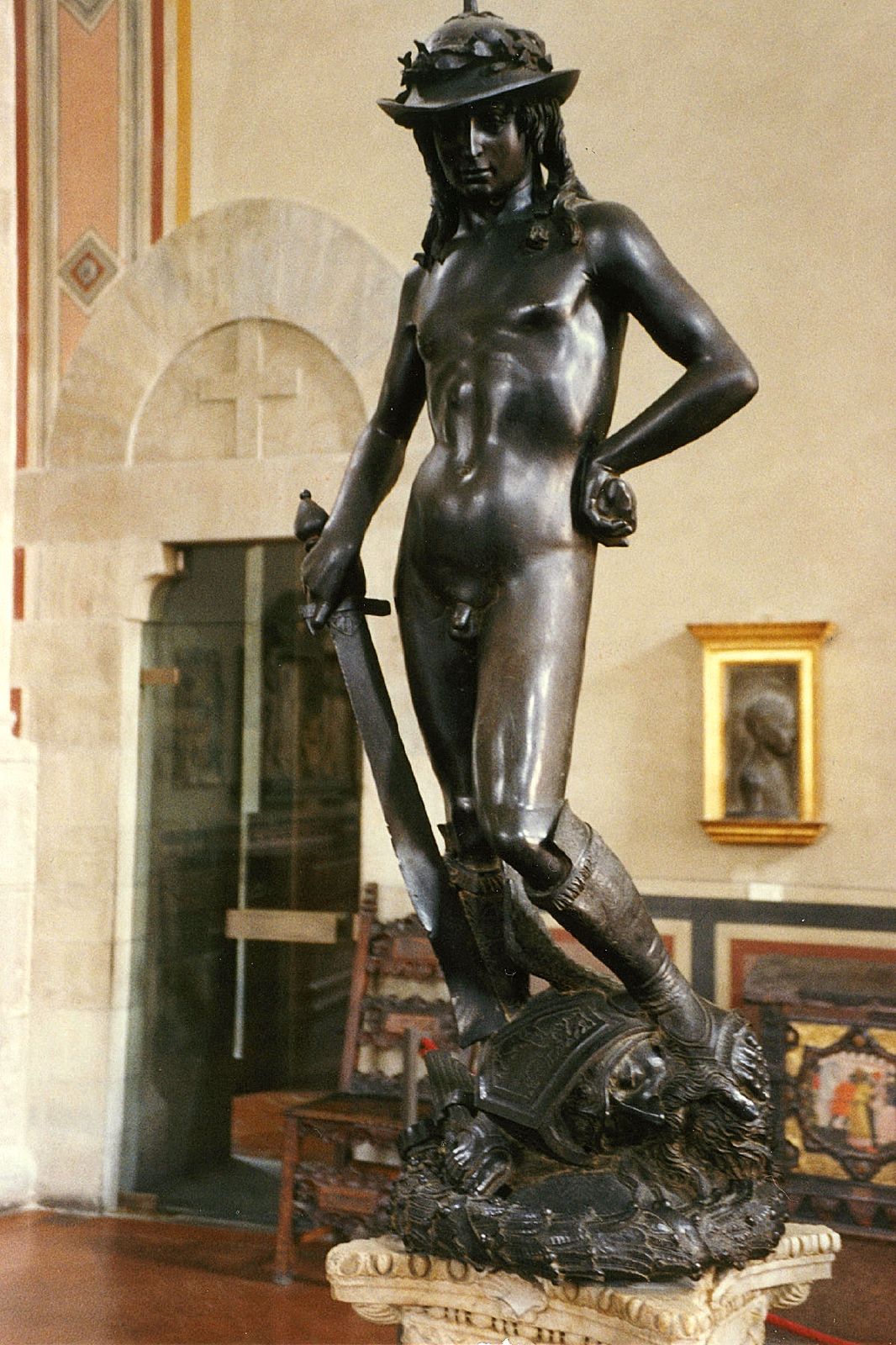
Donatello, David, 1425-1460
This sculpture was commissioned by the Medici family and is possibly the first free standing nude statue since ancient times. The contrapposto stance, with the figure's weight on one leg and the opposite arm engaged, recalls ancient Greek sculpture. The pose was thought to be indecent and idolatrous so was used rarely in art until this time. With this work, Donatello essentially reinvented the classical nude.
Andrea del Verrocchio
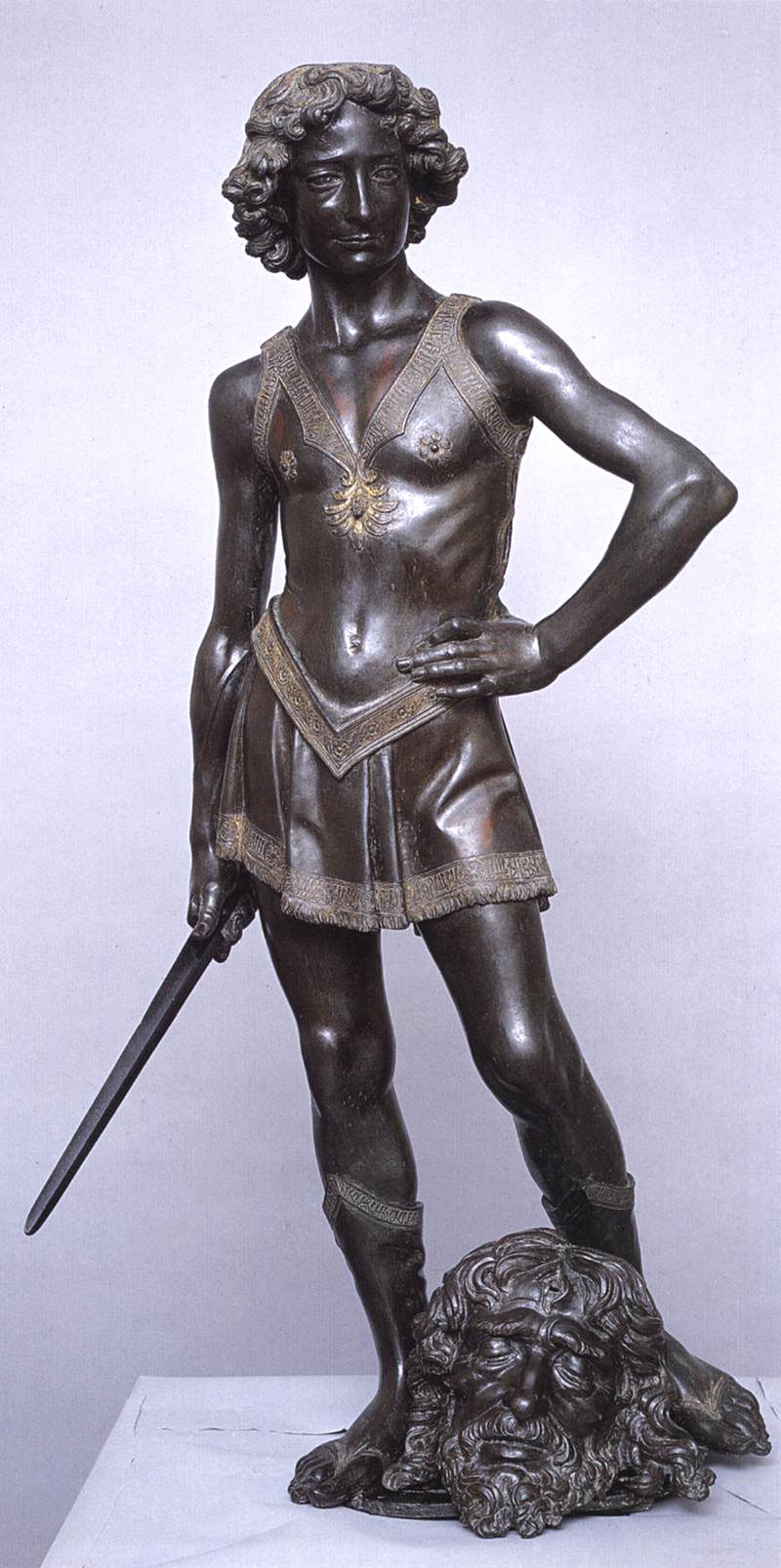
Andrea del Verrocchio, David, 1465-1470
This sculpture of the David was also commissioned by the Medici. Andrea del Verrocchio (1435-1488) was a noted painter and sculptor whose narrative realism contrasts Donatello’s classicism. In Verrocchio's depiction, David is a poised and self-assured young man standing astride his prize with pride. Verrocchio's close study of musculature is evident here as is his understanding of the inner psychology of this brash, confident young man.
Equestrian Statues
Equestrian statues act as symbols of power and they attest to the growing popularity of portraiture.
|
|
|
|
Donatello, Gattamelata, Piazza del Santo in Padua, Italy, 1445-1450 |
Andrea del Verrocchio, Bartolommeo Colleoni, Campo dei Santi Giovanni e Paolo, Venice, Italy, 1483-1488 |
| Donatello was commissioned to create an equestrian statue of a recently deceased Venetian nicknamed Gattamelata. His name translated to Honeyed Cat, which was a word play on his mother’s name, Melania Gattelli. Donatello's sculpture took inspiration from classical equestrian statues, like that of Marcus Aurelius, and was the first to rival those from antiquity. Gattamelata is not shown as a superhuman or greater than life-size. He thus dominates with force of character rather than size. The orb symbolizes his rise to a commanding position in the world through his character. |
This equestrian statue also shows a Venetian. Colleoni left money for this commission in his will. It shows the horse and rider in a bold pose and is placed higher on a pedestal so it looked even more imposing than Donatello's portrait. The horse strides powerfully forward iand the rider sits high in the saddle with an air of power and authority. |
Luca della Robbia
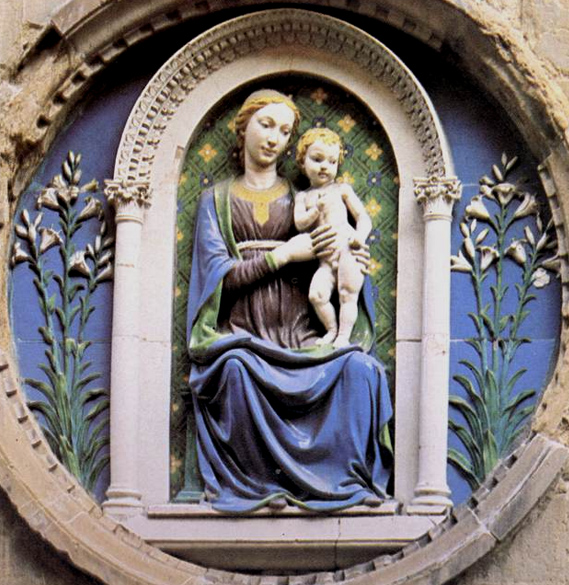
Lucca della Robbia, Madonna and Child, Orsanmichele, Florence, Italy, 1455-1460
The demand for devotional images and the decortion of private chapels provided further commissions for artists. Lucca della Robbia (1400-1482) fused potters' glazes to terracotta reliefs to produce images that were affordable to a wider range of patrons. He became famous for the firing techique he developed and the naturalistic style he used. The vibrant colors gave a sense of liveliness to the image.
Brunelleschi was an architect as well as a sculptor. He is said to have turned to architecture after failing to receive the commission to decorate the doors of the Baptistery in Florence. He traveled to Rome, possibly with Donatello, and studied the ancient ruins there in an effort to better understand structure and geometry. He would become the first major architect of the Renaissance.

Brunelleschi, Dome of the Florence Cathedral, 1420-1436
The Cathedral in Florence had been begun by Arnolfo di Cambio in 1294 on the site of an earlier, smaller church. By the beginning of the fifteenth century, the structure was still not complete. The last obstacle to be overcome was engineering a way to cover the huge crossing of the transcept, where the shorter side arms met the long central arm, or nave. The opening is 140 feet in diameter, which is too large for the two techniques that were typically used to build arches and domes. Church fathers wanted to keep using the altar, which was already in place under the transcept, so wooden centering could not be built over that space. Second, there was no way to buttress the walls for support.
To solve this problem, Brunelleschi had to invent new building methods, machinery with which to build it, and come up with a design thta discarded the traditional hemispherical shape and building techniques associated with hemispherical domes. His solution was to raise the center of the dome itself to create more of an egg shape, and plane it into a pointed arch section. The result was was more stable and the dome could be built in the air without centering. He also designed a thin double shell around a skeleton of twenty-four ribs, which were anchored by a heavy white lantern on the top. Despite his mind-bending innovations, the design and construction techniques Brunelleschi used relied in part on older, Gothic traditions, so the dome, while being his most noted accomplishment, is not typical of his style.
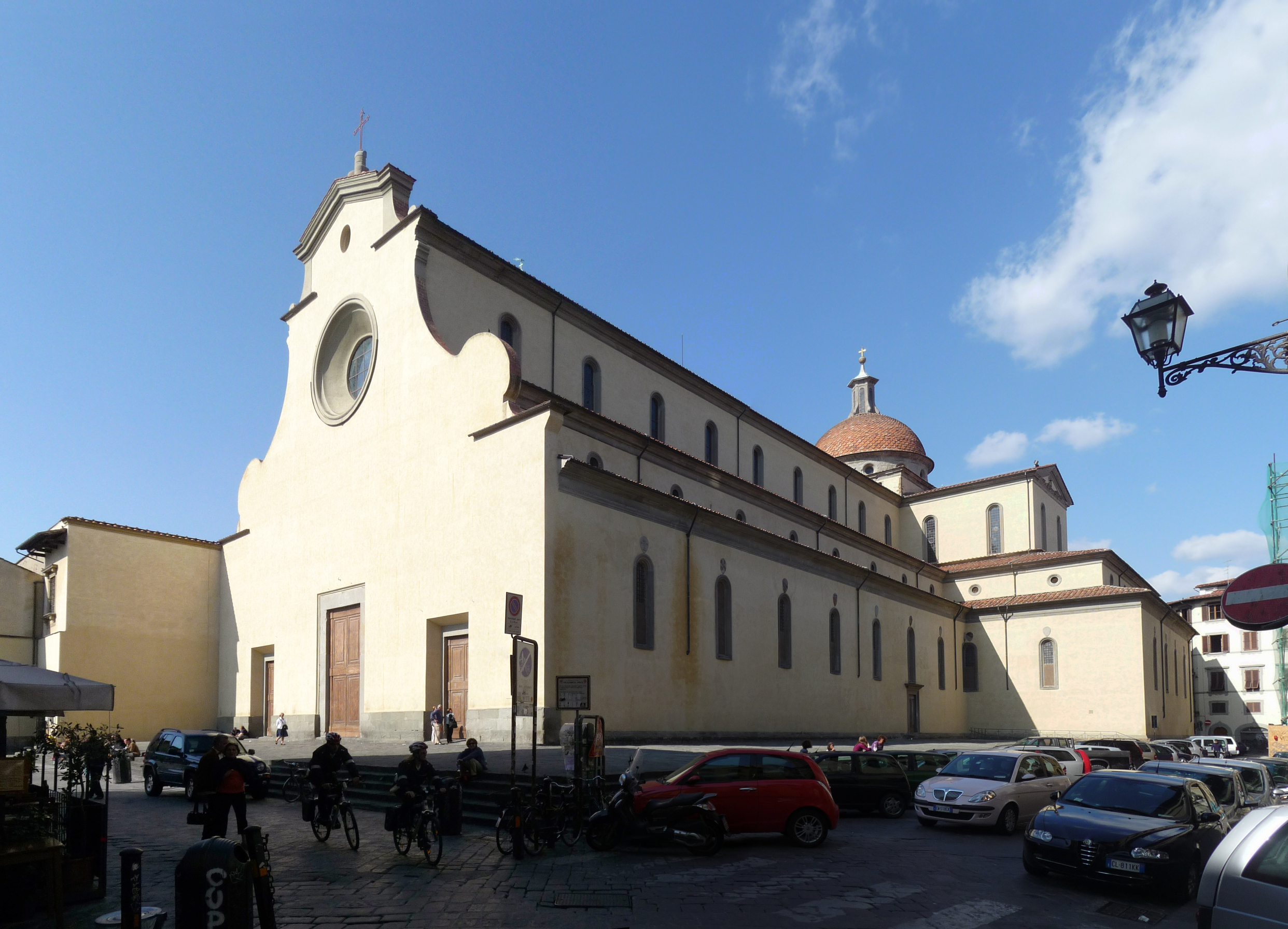
Brunelleschi, Santo Spirto, Florence, Italy, 1436
Santo Spirito is more of a testament to the clarity and rationality of Brunelleschi's architectural design. The church uses a basilica-style Roman cross plan, which draws focus to the centralized section of the crossing and to the dome. The side aisle wraps around the front and had to be altered to conform to the traditional three door entrance. Brunelleschi based his design on rational proportions, using a ratio of 1:2 or 1:1, which results in an overall harmonious relationship between the parts and the whole. There is not space in this church for decorative painting and sculpture either, so the viewer is not distracted by the pure concept of the building itself and it becomes a work of art in its own right.

Brunelleschi, Pazzi Chapel, Santa Croce, 1440
Unlike Santo Spirito, the space of Santa Croce was designed with a central plan, which is a nod to ancient classical structures and rational proportion. It is somewhat rectangular but the emphasis is still placed on the central dome. Gray stone and colorful terracotta medallions representing the evangelists contrast with the white stucco.
Early Renaissance Painting
In the late fourtheenth and into the fifteenth centuries, the International style was derived largely from Gothic tastes. Works done in the International style were often flat and decorative. Early Renaissance artists acted as a bridge between that style and the naturalism and the pursuit of one-point perspective that we've seen in Alberti's treatise On Painting (1430) and with Ghiberti's work on the Gates of Paradise for the Florence Baptistery. Many of the most famous artists were painters because it was a relatively inexpensive medium and innovations in new painting materials made it easier to use and adapt.
Masaccio
Masaccio (1401-1428) was a leading innovator in the realm of painting. His actual name was Tommaso Guidi or Tommaso di ser Giovanni and the name Masaccio seems to be an affectionate nickname meaning "Clumsy" or "Messy Tom." Stylistically, his paintings looked much like those by Giotto, but Masaccio also incorporated design elements learned from Donatello and Brunelleschi.

Masaccio, Tribute Money, Branacci Chapel, Santa Maria del Carmine, Florence, 1427
The Tribute Money shows a seldom represented narrative from the Gospel of Matthew. In it, a tax collector confronts Christ at the entrance of the Roman town of Capernaum. Christ and Saint Peter go to the shore of Lake Galilee, where Saint Peter finds the exact amount he needs, a half drachma, in the mouth of a fish to pay the tax (also called the tribute). This painting shows three scenes from that story. The fresco is notable for the way Masaccio conveys the personality of each figure - the sullenness with which Saint Peter pays the tribute, the frivolousness of the tax collector, whose face, pose, and costume suggests frippery, the confusion and concern of the other men in the central scene, and Christ's calm.
Moreover, there is a unified light source and corresponding shadows. Masaccio's figures seem to share the body structure and movement of Donatello's sculptures. The figures are set against a spacious landscape rather than the confined stage-like settings of earlier works. One-point perspective with vanishing point behind Christ’s head further emphasizes the depth of field along with incorporation of atmospheric perspective.
Of Masaccio, Vasari stated, "the works made before his day can be said to be painted, while his (Masaccio's) are living, real and natural" (quoted from Kleiner 432).
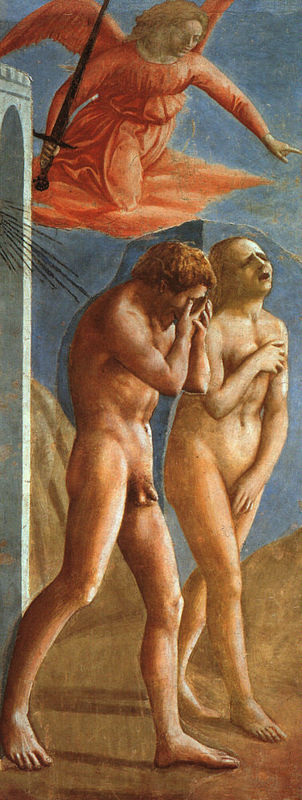
Masaccio, Expulsion of Adam and Eve from Eden, Brancacci Chapel, Santa Maria del Carmine, Florence, Italy, 1427
The sense of volume in the painting is generated by the sharply slanting light, which shines onto the scene from an outside source. At this moment, when man and woman exit paradise and enter the Earthly realm, Masaccio shows them with their feet firmly planted on the ground, their bodies heavy with disbelief and grief. They clutch their eyes and bodies as the stumble blindly forward, driven by the angel's will. This level of emotion is new, too.
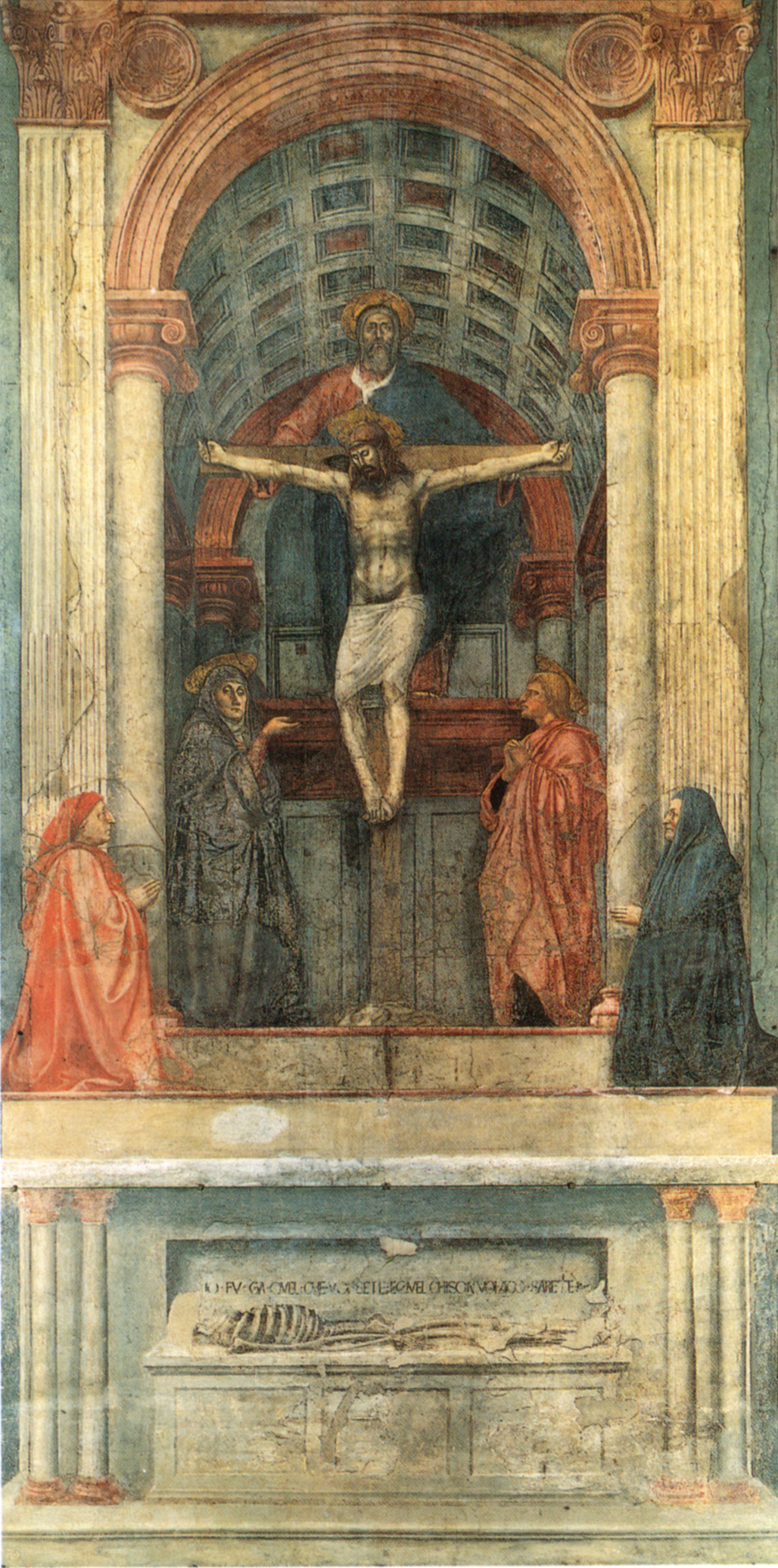
Masaccio, Holy Trinity, Santa Maria Novella, Florence, Italy, 1428
This painting shows how artists increasingly relied on observation to achieve a more naturalistic style. Masaccio applied mathematics to the pictorial organization of this composition to achieve one-point perspective. God-the-Father, in human form, supports the weight of Christ while the donors look on in eternal devotion. Images of donors - these portraits in action - are present in many paintings because they immortalize the spirit of the donors themselves and allows for others to recognize and appreciate their efforts. To drive this point home, an illusionistic tomb below contains a skeleton and is inscribed, "I was once what you are, and what I am you will become."
Because the perspective is so convincing, some believe that Brunelleschi may have collaborated on this project with Masaccio. The vanishing point for the scene is located about 5 feet from the floor, at the base of the cross. thereby lining up with the natural vanishing point for the average viewer. The math behind the perspective is so exact that we can figure out that the chapel would be seven feet wide by nine feet across if it existed in real space.The arrangement of the figutres in a pyramid or triangle draws the viewer up in and into the work, and further emphasizes the illusion of the space.
Paolo Uccello
Paolo Uccello (1397-1475) was trained in the International style, which built on many of the stylistic traditions of the late Gothic period. He was also influenced by the principles being developed in Florence, however. In showing a historic battle scene, the painting below broke from the usual practice of representing primarily (and almost exclusively) religious subjects.
_01.jpg)
Paolo Uccello, The Battle of San Romano, Galleria degli Uffizi, Florence, Italy, 1455
This painting was one of a series commissioned by the Medici to commemorate the Florentine victory over the Sienese in 1432. The Medici are referenced symbolically through the apples on the trees behind the soldiers' lances (a reference to the Medici Apples). Uccello's composition shows a new level of obsession with one-point perspective: discarded weapons fall to create perfect orthogonals on his almost checkerboard ground. The farmland in the distance both gives a sense of depth to the space and refers back to the classical Battle of Issus, a Greek painting showing Alexander the Great that had been reproduced as a Roman mosaic:

Sandro Botticelli
Sandro Botticelli (1444-1510) was one of the best known artists who worked for the Medici. The Medici often commissioned the classical, mythologically themed images that appeared in many of Botticelli's works, including La Primavera and his now iconic Birth of Venus:

Sandro Botticelli, Birth of Venus, Galleria degli Uffizi, Florence, Italy, 1482
The painting depicts a classical mythological theme with Zephyrus, the west wind, blowing Venus, who is born of the sea foam, to her sacred island, Cyprus. On the shore, she is met by the nymph Pomona. The large-scale painting shows a female nude as part of a pagan theme, but the painting and its subject went unchallenged due to the power of the Medici. Botticelli was less concerned with capturing the correct proportions of the figure than he was with creating an elegant composition. One might liken the painting to poetry rather than rationality.

Botticelli, Portrait of a Youth, National Gallery of Art, Washington, DC, 1480s
The rise of portraiture in painting is evident in Botticelli's work as well, as is a new interest in the individual. The profile portraits of earlier generations gave way to frontal and three-quarter views and busts in the tradition of Roman portraiture. This new style allowed artists to more accurately capture the expression and personality of the sitters. When painting, Botticelli often first firmly outlined his forms and then added light shading so that the focus becomes the line.
Domenico Ghirlandaio
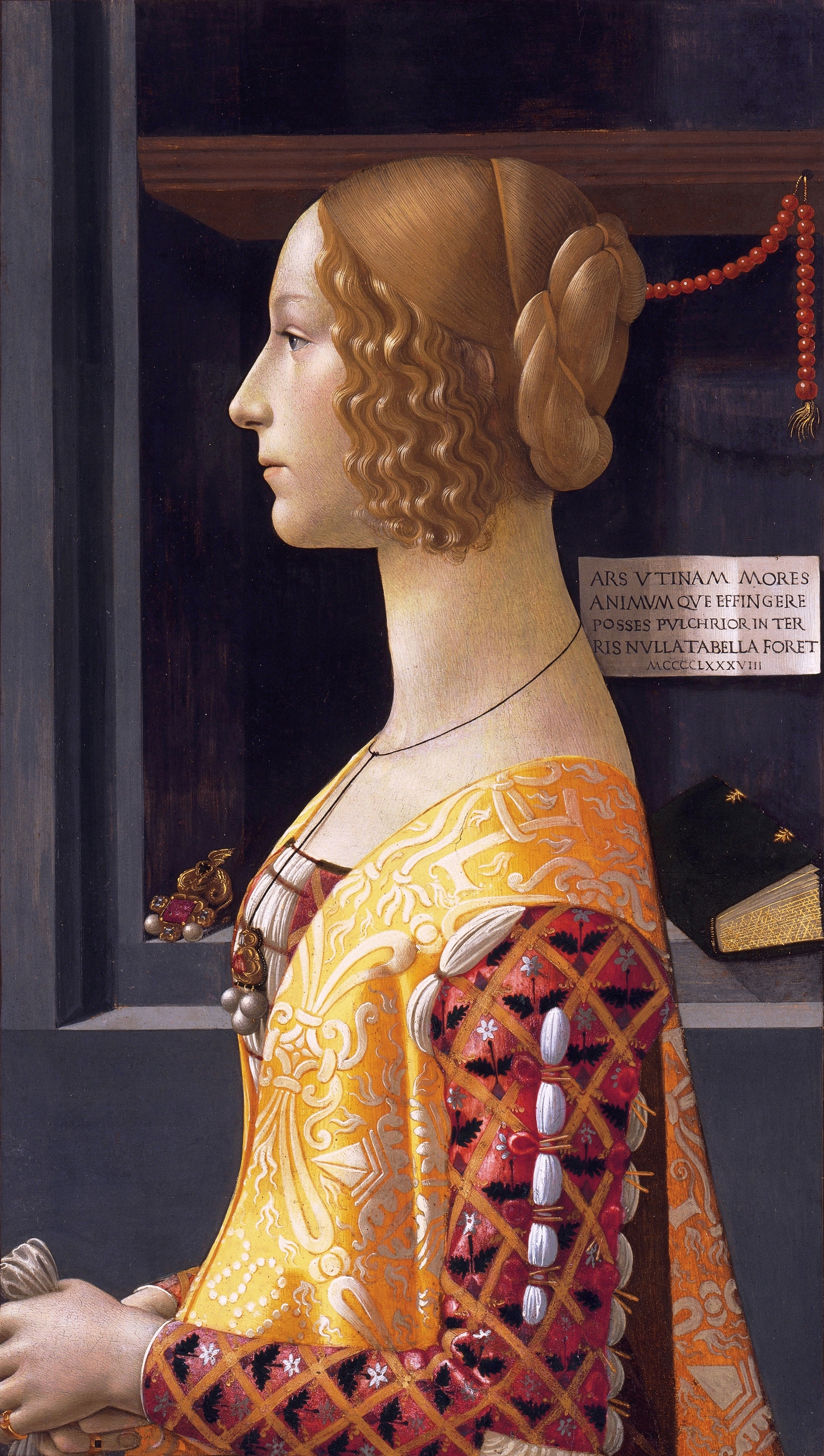
Domenico Ghirlandaio, Portrait of Giovanna Tornabuoni, Museo Thyssen-Bornemisza, Madrid, Spain, 1488
Women were also subjects for portraiture. Before and during the Early Renaissance, men and women were both often shown in profile in their portraits. Artists painting portraits of men were the first to turn the sitter to face the viewer, as seen with Botticelli’s portrait of a youth. Women were shown in profile for longer, though. Leonardo da Vinci was the first artist that we know of to depict a woman in a three-quarters pose, but even after he had started doing so in the last quarter of the fifteenth century, most portraits of women still showed them in profile. Portraits of women were most often painted on the occasion of their weddings, and they are shown wearing the finery – both in their clothing and jewelry – that made up their dowry, and the portrait captured and celebrated the riches they would bring to their husbands’ families. Such is the case with Ghirlandaio’s portrait of Giovanna Tornabuoni,
Portrait profiles did not reveal the same depth of character and personality as Botticelli's three-quarter portrait better demonstrates. Ghirlandaio’s portrait of Giovanna Tornabuoni does include an allusion to classical literature through the inclusion of the epitaph written on paper in the background.

Ghirlandaio, Birth of the Virgin, fresco, Cappella Tornabuoni, Santa Maria Novella, Florence 1485-1490
This painting summarizes the state of Florentine art toward the end of the 15th century and it epitomizes the achievements of Early Renaissance painting. The corporeal, statuesque figures are set within a clearly defined space, which recedes convincingly into the distance using one-point perspective. There is still a sense of artificiality here with the shallow, stage-like space in which the figures stand in bands or layers parallel to the picture plane.
Fra Angelico

Fra Angelico, The Annunciation, resco, Convent of San Marco, Florence, Italy, 1437-47
Fra Angelico departed from the humanistic trends in Florence as he personally devoted himself to serving the Roman Catholic Church. The Annunciation was painted as part of a series for the Dominican brothers of the monastery of San Marco in Florence. Fra Angelico painted frescoes in each of the monk’s cells to instruct the monks in the ways of prayer. Fra Angelico’s compositions were simple and serene, almost meditative. The inscription here reads: "As you venerate, while passing before it, this figure of the intact Virgin, beware lest you omit to say a Hail Mary."
Fra Filippo Lippi

Fra Filippo Lippi, Madonna and Child with Angels, oil and tempera on canvas, Uffizi Gallery, Florence, Italy, 1455
Many believe that Fra Filippo Lippi was Sandro Botticelli’s teacher because of the similarity of their painting techniques. Fra Filippo Lippi was a friar, but was apparently a bad one as he dabbled in forgery and embezzlement, and later had an affair with a nun who later had his son. His fluid linear style emphasizes the contours of his figures and suggests movement through flowing draperies. He seems to have used live models and he closely observed nature and the personalities of individuals. We get a feeling of tenderness in his painting of Madonna and Child with Angels through the Virgin’s serene expression and the gesture of the Christ child – who actually looks like a baby – as he reaches for his mother. The landscape behind the figures seems more like a real place as it would be observed in real life as well. The humanist impulse reaches a new level in this work as it raises otherwise mundane subject and objects to a profound level.
Perugino (Piertro Vannucci)(1450-1523)
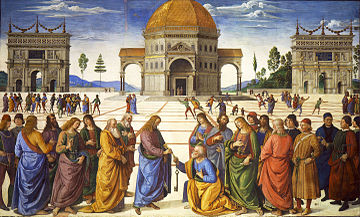
Christ Delivering the Keys of the Kingdom to Saint Peter, fresco, The Sistine Chapel, Vatican, 1481.
This painting was part of a series of frescos by painters including Botticelli, Ghirlandaio, and Luca Signorelli, who were commissioned by Pope Sixtus IV to decorate the newly built Sistine Chapel in Rome. The painting depicts the basis of the Roman Catholic Church’s authority. The figures make up the apron of a great stage. Perspective vanishes into the doorway of a central plan church where the arches are based off the arch of Constantine and remind viewers of the connection between Constantine and St.Peter’s basilica. There is an incorporation of two-dimensional design to a three-dimensional illusionistic space. The typical triangle composition is formed by perspective framing Jesus and Peter.
Andrea Mantegna
Many artists in Northern Italy attempted to follow Mantegna’s work. He was an engraver whose prints found their way into Germany and influenced Albrecht Durer in the 16th century. He was also well noted for his work in the Camera degli Sposi (room of the newlyweds) in the Palazzo Ducale of Ludovicio Gonzaga, which were triumphant feats of pictorial illusionism where he created a consistent illusionistic decoration of an entire room, similar to second style Roman painting.
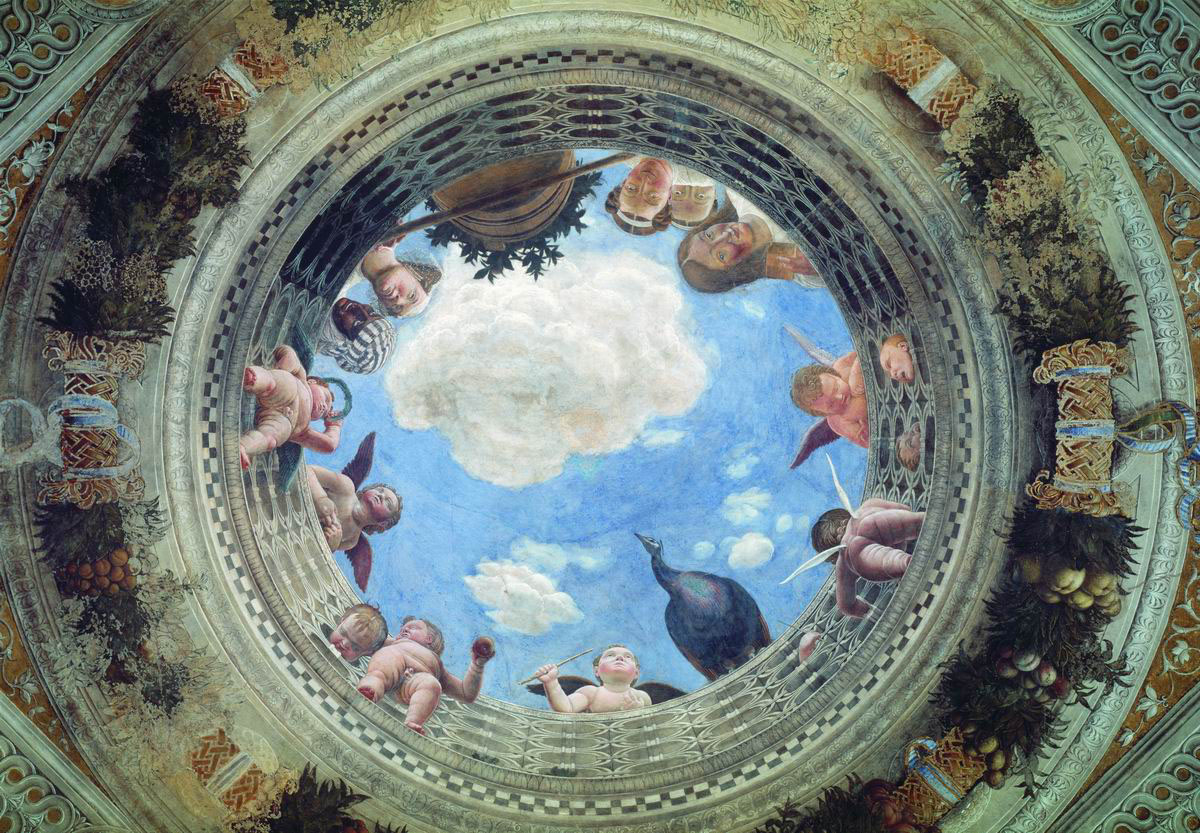
Ceiling of the Camera degli Sposi, fresco, Palace Ducal, Mantua, Italy, 1474.
The painting represents Trompe l'oeil ("fool the eye") design. It was also the first di soto in su ("from below upwards") perspective of a ceiling, a theme that later was further used and developed in Baroque time. The oculus becomes an eye both looking up and down. The figures demonstrate various symbols of fertility as this was the wedding room for the couple. The peacock is an attribute to Juno, Jupiter’s bride who oversees lawful marriages and the putti that are depicted are to provide good fortune and fertility to the newly wed couple.

Saint James Led to Martyrdom, fresco, Overtari Chapel in the Church of the Eremitani, Padua, Italy, 1455 (now destroyed).
This is an earlier fresco that shows his early tendencies to odd angles and interesting illusionism. In the painting, Saint James stops on his way to his own death to bless a man. Mantenga strove for historical authenticity in attire and architecture. The perspective is also important to his scenes as he sets himself up in an interesting angle that relates also to the viewer's vantage point. He ignores the third perspective point for rational composition and breaks the verticals with the flagstaff. The painting was unfortunately destroyed during bombings of World War II.

Dead Christ, Pinacoteca di Brera, Milan, Italy, 1501
The painting demonstrates another interesting perspective into a very descriptive scene of mortality. The foreshortening is not quite correct as Mantegna again adjusts proportion in an effort to maintain narrative importance.
Luca Signorelli

Damned Cast into Hell, San Brizio chapel, Orvieto Cathedral, Orvieto, Italy, 1499-1504
The passion of the time found its way into art. Signorelli's painting demonstrates furthered interest in the depiction of muscular bodies in violent action. The major emotive impact represents a bridge from the early Renaissance into High Renaissance interests while also demonstrating the consequences of a sinful life, which had not been depicted since the Gothic sculptures over the tympanum of cathedrals. It seems to have been done from studies from models. The color also is interesting and adds to the narrative as devils and fiends have flaming hair and bodies the color of putrid flesh.
High Renaissance Painting
The High Renaissance is marked by many of the iconic figures that we have come to know. The artists at the end of the Renaissance pushed the stylistic properties and techniques available to artists. Their efforts transitioned the somewhat stale representations based on early classical Greek artifacts toward more dramatic imagery based on the high classical and Hellenistic eras of Greek art.
Pope Julius II (r.1503-1513): Pope Julius II was considered the "Warrior Pope." He believed in the power of art as propaganda. He also wanted to revive the old Rome by making a new Saint Peter’s Basilica and other monuments. His efforts led to the commission of many large-scale projects that required the increased sale of indulgences as revenue. This artistic patronage led to the Reformation as a backlash, mostly by distant city states, as they were not benefiting from these taxes or initiatives, among other issues with the Roman Catholic Church.
Leonardo Da Vinci (1452-1519)
Da Vinci studied in the studio of Andrea Del Verrocchio. His varied interests included botany, geology, geography, cartography, zoology, military engineering, animal lore, anatomy, and physical science, all of which which informed his art. Though well respected, Da Vinci often found himself moving from city to city in order to make a living. He eventually left Florence to offer his services to the Duke of Milan and, on his travels, died in France.
.jpg)
Virgin of the Rocks, Oil on Panel, National Gallery, London, 1485.
(From left: John, Mary, Christ, Angel)
The painting is built off the ideas of chiaroscuro (subtle play of light and dark) and a technique by Da Vinci labelled "sfumato," a misty haziness that Leonardo used as he visually blurred precise planes and lines and subtly adjusted the light. To Da Vinci, expressing emotional states was extremely important:
A good painter has two chief objects to paint – man and the intention of his soul. The former is easy, the latter hard, for it must be expressed by gestures and the movement of the limbs… A painting will only be wonderful for the beholder by making that which is not so appear raised and detached from the wall.
In much of the tradition of the time, the painting is designed using a triangular composition and a believable space is created through atmospheric perspective. There is also visual unity created through the gestures of the figures. Overall, the painting demonstrates the tenderness of emotion.
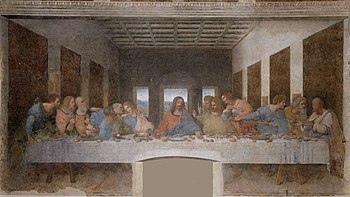
The Last Supper, tempera and oil on plaster, Santa Maria della Grazie, Milan, 1495-1498
This painting was commissioned for the refectory for the church of Santa Maria delle Grazie in Milan. It is one of his most impressive works though it has been greatly lost due to his experimentation with materials and poor restorations from the past. The scene immediately follows the statement that one of the apostles is to betray Christ.
The careful composition isolates Christ as the focal point. The disciples are in four groups of three united in gestures and interaction. Da Vinci places Judas on the same side of the table clutching a money bag, reaching out to fill the chalice of Christ and is in shadow. There are also some who question the long-haired figure to Christ's left believing it could be Mary Magdalene. Each sitter is charged with an individual emotive response to the statement.
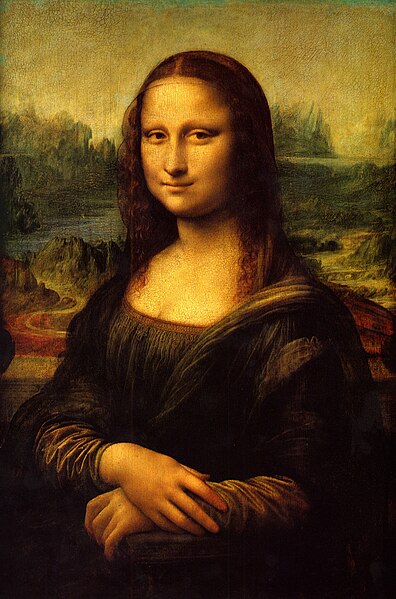
Mona Lisa,Oil on Panel, Louvre, Paris, France, 1503-1505
The identity of the sitter is uncertain: Vasari asserted that she is Lisa di Antonio Maria Gherardini, wife of a wealthy Florentine (“My Lady Lisa”). The painting itself is notable as a convincing representation of an individual rather than an icon of status. The composition is half length, hands folded and gaze directed toward the viewer. Her "smile" has become famous as a mysterious emotive effect. The background contains a fantastic landscape previously bordered by two columns as she appeared to be sitting in a loggia (columns later removed when the painting was cropped).
Leonardo completed very few paintings due to his experimentation and perfectionism. Many of his drawings were well preserved in notebooks which recorded his ideas. They demonstrate not completely accurate depictions scientifically, but for their time they are well advanced. His studies originated a method of scientific illustration. Though he dabbled in sculpture, he did many drawings of equestrian sculptures and created a few, however none have survived or been attributed to him.
Raphael (Raffaello Santi)(1483-1520)
Raphael was a painter also under the commission of Julius II. He received the commission to decorate the Papal apartments in the Vatican. In these apartments, he presented images to sum up Western learning as Renaissance society understood it in the library. These paintings pointed out the virtues and learning appropriate to the pope, balancing the imagery between theology and philosophy.

Philosophy (School of Athens), Sistine Chapel, Vatican, 1509-1511
The painting shows a congregation of great philosophers and scientists of the ancient world. The architecture recalls Roman bath complexes, where men would gather in discourse. The statues present represent Apollo and Athena, God and Goddess of arts and wisdom. Plato and Aristotle serve as central figures and others are carefully arranged around them, separated by the two schools of thought. Plato holds his book, Timaeus, and points to heaven, while Aristotle carries Nichomaechean Ethics and gestures toward earth, from which his observations of reality sprang. Men concerned with the ultimate mysteries that transcend this world are on Plato’s side. Philosophers concerned with nature and human affairs on Aristotle’s side. Pythagoras writes as a servant holds up a harmonic scale, and other philosophers hold up similar identification devices in a naturalistic way as if explaining to others their ideas. Raphael’s own self portrait can be found between the astronomers Zoroaster and Ptolemy on the right.
The painting is a convincing depiction of vast pictorial space. It graphically demonstrates the union of mathematics and pictorial science. Raphael provides great psychological insight in each figure much like Leonardo’s Last Supper. He also drives the viewer's attention around to each one by groups of figures arranged in an elliptical movement beginning from the center, breaking from the traditional triangular compositions seen previously.
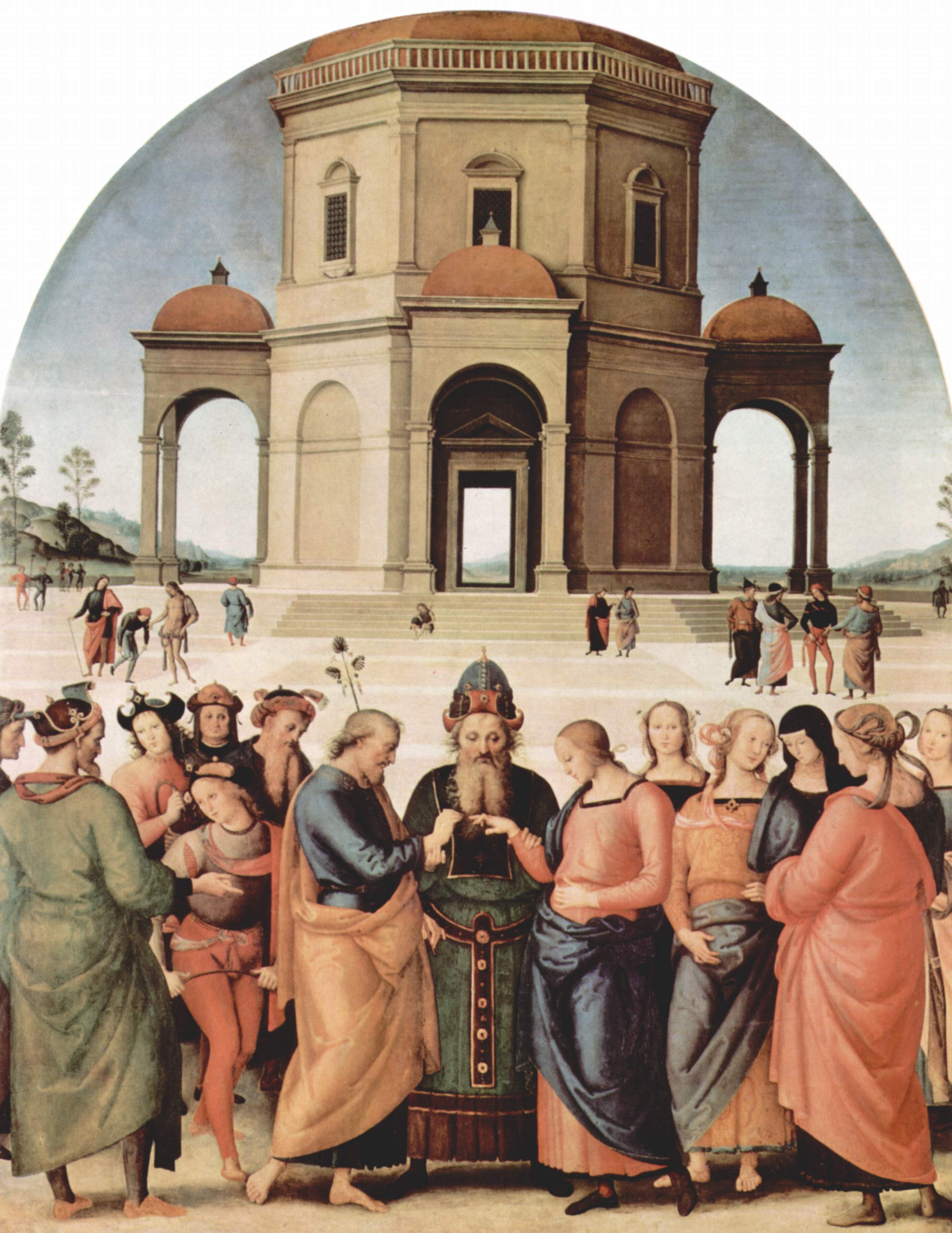
Marriage of the Virgin, 1504
Raphael developed an individual style that depicts the ideals of the High Renaissance. He assimilated ideas from all the other artists around him. This painting depicts a rare story according to the Golden Legend, (13th century collection of stories about the lives of the saints). In the story, Joseph competed with other suitors for Mary’s hand. The high priest was to give the Virgin to whichever suitor presented to him a rod that had miraculously bloomed. In the painting, unsuccessful suitors stand to the right and virgins to the left. Many of the aspects of perspective and design seen throughout Renaissance painting are again presented in this composition.

Alba Madonna, National Gallery of Art, DC, 1510.
There are many similarities to Leonardo’s compositional depiction; however, Raphael chooses a brighter palette based off paintings by Perugino. He preferred clarity to obscurity and was not fascinated with mystery as Leonardo was.
Early 16th Century Venetian
Venice was a major Mediterranean coastal port and gateway to the Orient. It was a city state that remained independent from France or Spain during their conquests. They had a semi-democratic structure that involved an election of their duke, called a Doge. The city state witnessed a later decline from constant threat from the Turks and other powers.
Giovanni Bellini (1430-1516)
The effects of Venice’s soft light were of much interest to artists. Evocative use of color became known as "Venetian style." Bellini trained in the International Style by his father Jacopo, a student of Gentile da Fabriano. He also was highly influenced by Mantegna and a Sicilian painter, Antonello da Messina. Bellini is most noted for beginning the use of mixed oil rather than tempera or fresco. This practice of oil painting was important for Venice where the climate did not allow for fresco to remain on the walls. Bellini and other artists of Venice often created paintings of the Virgin in sacra conversazione (holy conversation).
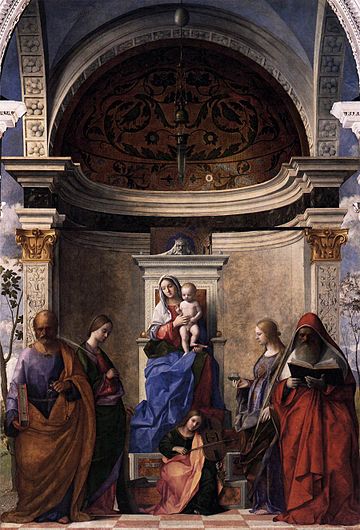
San Zaccaria Altarpiece, San Zaccaria, Venice, 1505
Bellini Refined many of the compositional elements of previous altarpieces. He uses physical or symbolic attributes help to identify all the saints except Lucy (usually depicted holding her eyes). There is a sense of calm serenity. Though this is a sacra conversazione piece, there is little or no interaction taking place between the figures. The painting does demonstrate the balance of color and light typical of Venetian Style paintings where, as a product of the oil painting process, line is not the main element, but rather light, color, and shadow.

The Feast of the Gods, National Gallery of Art, Washington, DC, 1529
This painting was commissioned by the Duke of Ferrara, Alfonso d’Este for a room in his Palazzo Ducale. As it was a secular location, the mythological theme was of private interest to the Duke. The composition draws from standard Greco-Roman poses and figures. The gods look almost like peasants enjoying a picnic, but the source is from Ovid’s Fasti which describes a banquet of the gods. Nymphs and Satyrs attend to the gods who enjoy their party.
The painting was originally a scene circled by trees, but later Titian (student of Bellini), re-painted much of the background to meet with his neighboring painting. The Venetian painting became a contrast of colorito (colored or painted) vs. disegno (drawing or design) between Venice and the Florentine/Roman artists. The subject also focuses on the lyrical and poetic that were common themes in Venice.
Giorgione Da Castelfranco (1477-1510)
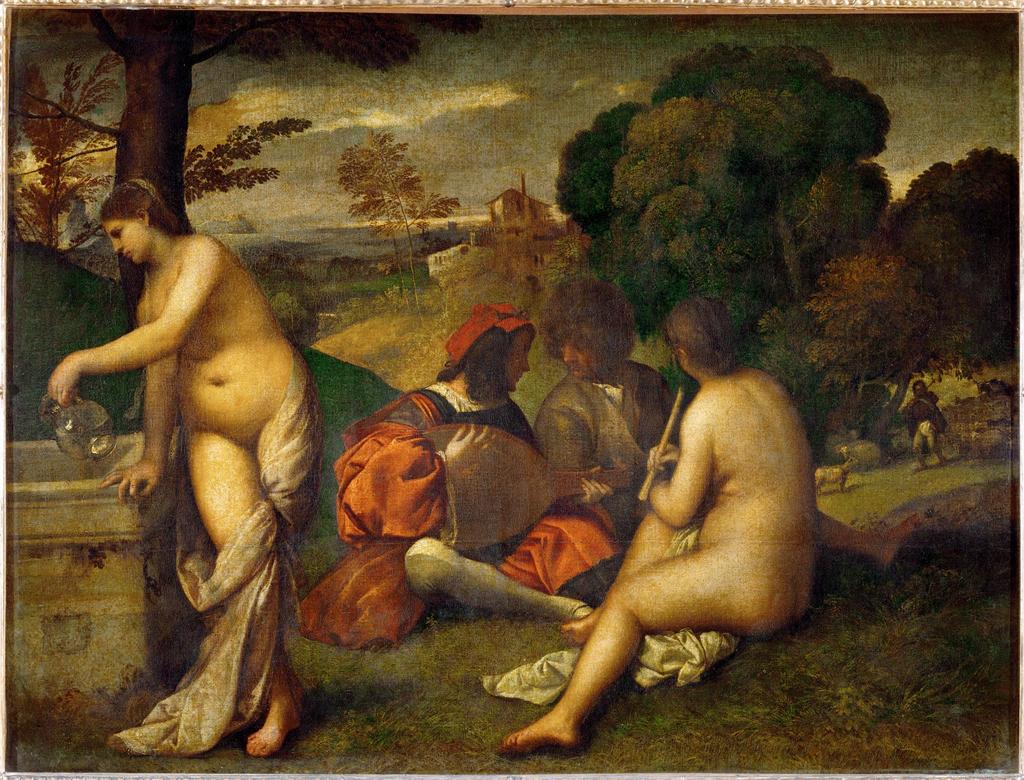
Pastoral Concert, Oil, Louvre, Paris, France, 1508
This painting is possibly an early work by Titian. It is also a great example of the Poetic paintings of the Venetians. The figures emerge out of dense shadow. The nude women are their muses, and are not actually physically present in this scene, representing an allegorical message. The one woman dips into the Well of Inspiration while the other pays loving attention to the two men who talk as if the women are not present. Voluptuous women become a standard of beauty for Venetian art.
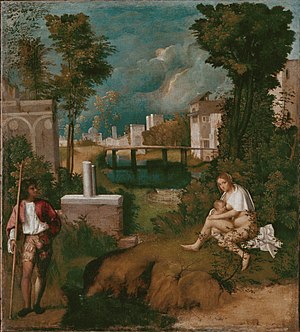
The Tempest, Gallerie dell'Accademia, Venice, 1510
This painting demonstrates similar poetic qualities. The landscape is threatened by stormy skies. It is uncertain if there is any particular narrative as it seems like it is a visual poem.
Titian (Tiziano Vecelli)(1490-1576)
Titian was trained by both Bellini and Giorgione. Upon Bellini’s death, Titian became Venice’s official painter. He was the most prolific and considered the greatest of the Venetian painters and a supreme colorist. He fully adopted oil on canvas as the preferred medium.
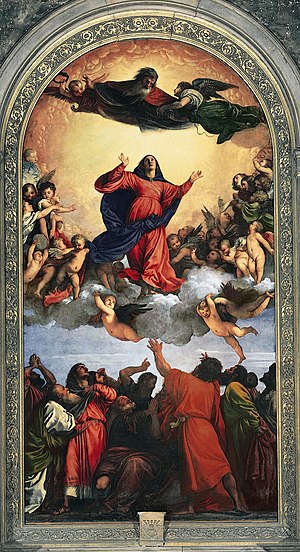
Assumption of the Virgin, Basilica di Santa Maria Gloriosa dei Frari, Venice, 1516-1518
This composition was painted for the main altar of Santa Maria Gloriosa dei Frari. It depicts the ascent of the Virgin’s body to Heaven. Golden clouds seem to glow and radiate light and the vibrant color allows him to bring forth an image with drama and intensity.

Madonna of the Pesaro Family, Santa Maria Gloriosa dei Frari, Venice, 1519-1526
This private commission is also located in the church of the Frari. It depicts a sunlit setting, in which the Madonna receives the commander Pesaro who kneels at the foot of her throne. The painting is characterized by the massing of monumental figures within weighty and majestic architecture, but Titian does not compose a horizontal and symmetrical arrangement, rather on a diagonal. This diagonal composition creates a more dynamic composition than those found in the High Renaissance.
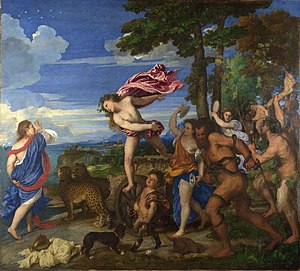
Meeting of Bacchus and Ariadne, National Gallery, London, England, 1522-1523
Another of the series commissioned by Alfonso d’Este, the duke of Ferrara. He had also commissioned a Bacchanalian scene from Titian as well as several other artists, but others had died before completing their commissions. Titian fulfilled the other artists' commissions as well as altered his teacher Bellini’s painting to fit with his own. Bacchus here is accompanied by a noisy group as they arrive to save Ariadne who was abandoned by Theseus on the island of Naxos. Bright, rich colors make Alfonso’s "pleasure chamber" a very desirable place to relax.

Venus of Urbino, Ufizi Museum, Florence, Italy, 1538
The title elevates the picture to the status of classical mythology when the painting was most likely of a courtesan in her bedchamber, and there is no evidence that there was any mythological meaning. The painting represents the connection of Renaissance art to Classical themes. The figure allows for viewers to connect with the painting in a formal sense rather than its most probable intention of a genre / pornographic image. The composition is balanced through a dividion of spaces and utilizes color as a major compositional element.
Antonio Allegri da Correggio (1489-1534)
Correggio is an artist from Parma. His unique personal style cannot really be classified. He pulled together many stylistic trends living between the Florentines and the Venetians.
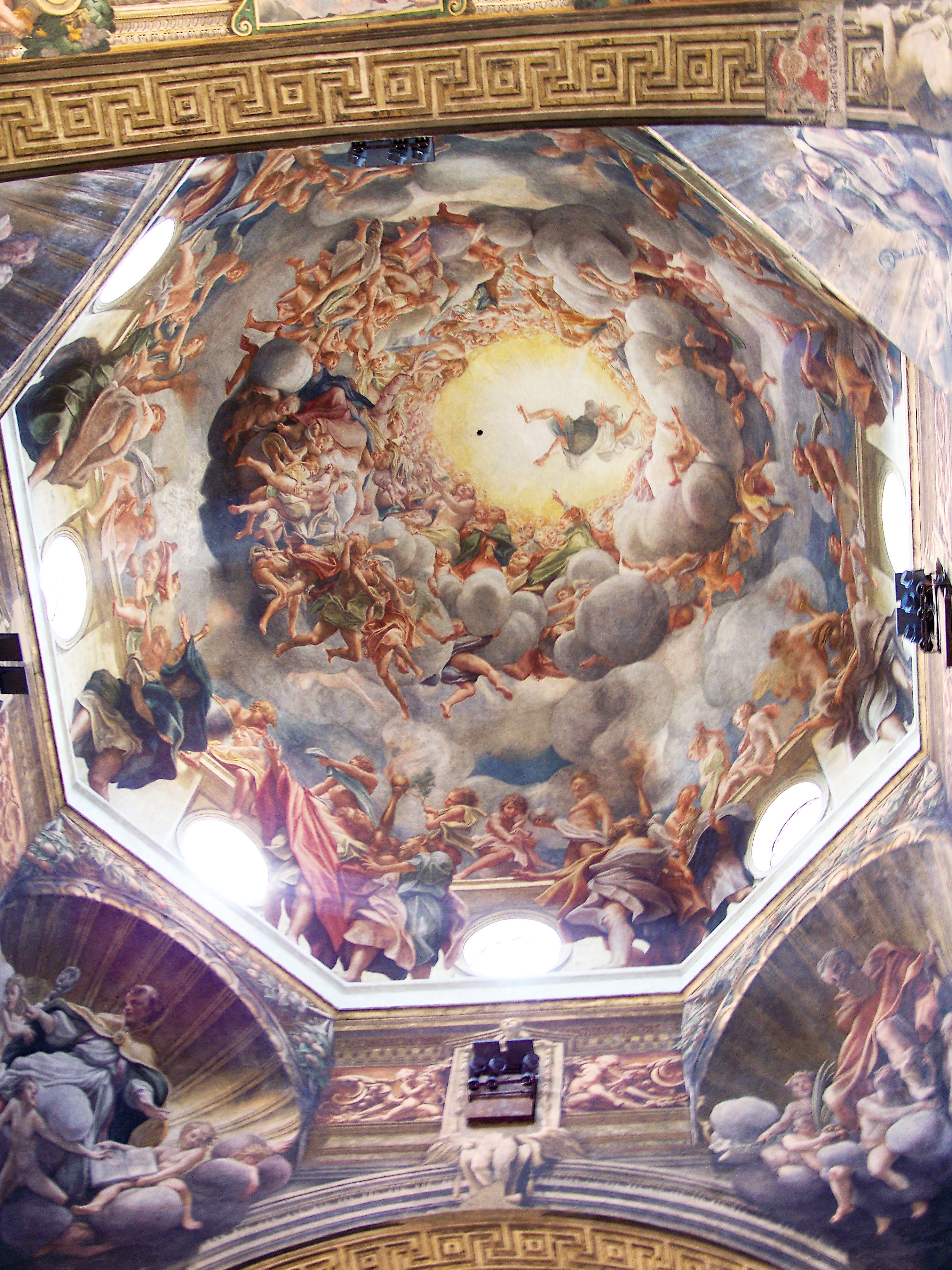
Assumption of the Virgin, Parma Cathedral, Parma, Italy, 1526-1530.
Correggio painted on the domed ceiling of the Parma Cathedral. The composition is similar to Mantegna’s Camera degli Sposi. He depicts an audience in the sky with concentric rings of clouds with hundreds of figures dancing in celebration as the Virgin ascends through the middle. Baroque painters later looked to Correggio for inspiration.
Michelangelo Buonarroti (1475-1564)
Michelangelo was the favorite of Pope Julius II. He thought of himself as a sculptor first, stating that the skill should be valued above painting as it takes a divine power to "make man." Artwork is the physical representation of an idea thet becomes the reality that the artist must bring forth. Ideas come from nature and is therefore linked to divine beauty. Michelangelo thus mistrusted the application of mathematical methods as guarantees of beauty in proportion, believing instead in measure of beauty by the eyes. As the hands work, the eye judges, therefore the artist’s inspiration could be best judgment of proportion and beauty. This emphasized the artist's right to self-expression and artistic judgment. Michelangelo was also known for his self-imposed isolation, creative furies, proud independence and daring innovations.
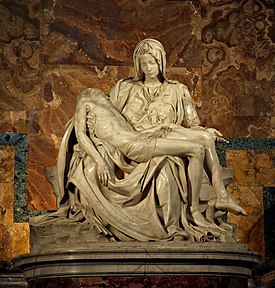
Pieta, Marble, Saint Peters Basilica, Vatican 1498-1500.
The Pieta demonstrates Michelangelo's prowess with sculpting marble. His care to anatomy, the lifelike poses and the emotion is without comparison. He captures an overly young Virgin Mary holding a limp Christ after the descent from the cross. This composition has been copied by many artists making it iconic in its symbolism and expression.
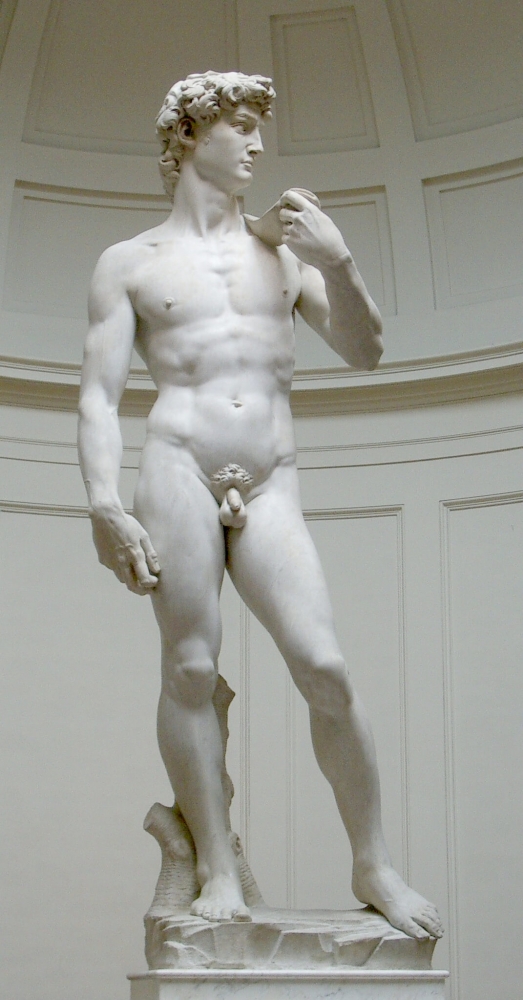
David, The Academy, Florence, Italy, 1501-1504
This sculpture is an early work revealing the fascination with the human form. The formal reference is to classical antiquity and the Doryphoros. Like earlier David sculptures that were commissioned in Florence during times of upheaval, this is representative of the city and its struggles against its rivals. In Michelangelo's depiction, he shows David before victory awaiting his foe, rather than after victory, standing over the head of Goliath. The pose and expression demonstrate tension and readiness and at the same time a relaxed poise. His large hands and head bring emphasis to the narrative focal points. This emotive force connects the piece more to the Hellenistic Greek tradition of showing pent-up emotion rather than focusing on calm, ideal beauty. The sculpture also maintains an immense physical presence as it stands over thirteen feet tall(13’5”).

Moses, San Pietro in Vincoli, Rome, 1513-1515
Moses is one of the sculptures for the tomb of Julius II which was commissioned during his lifetime but never completed to the extent of Julius II‘s wishes. It was meant to be seen from below and balanced with seven other figures related to it so it does not have its intended impact. The tablets of law are under his arm as he gathers his beard in his hands. He is also depicted with horns, which were a sculptural convention in Christian art to identify Moses due to a mistranslation regarding the rays of light that emanated from his head in the text. Moses's muscles also bulge, his veins swell, and he seems to look as if he is ready to stand. There seems to be a lot of pent up energy that would explode out if he were to stand up.
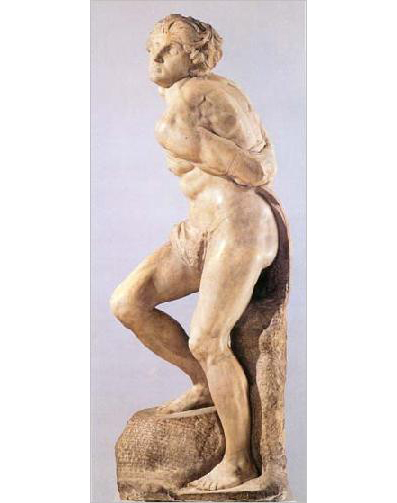
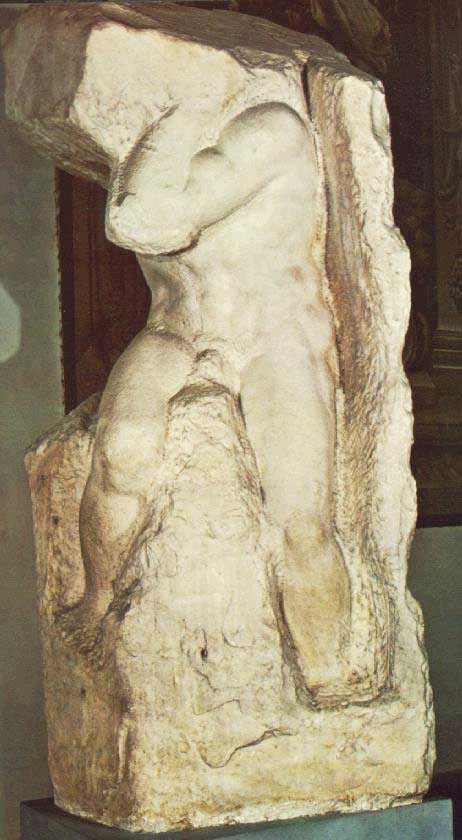
Bound Slaves, 1513-1516
The bound slaves were intended for around 20 sculptures of slaves to also appear on the tomb of Julius II, though many think that the sculptures might not have even been intended for the tomb. They embody powerful emotional states associated with oppression. They could have been personal expressions in sculpture rather than commissioned works.


Ceiling of the Sistine Chapel, Sistine Chapel, Vatican, 1508-1512
One of the most iconic of Michelangelo's works, it was also commissioned by Julius II to a reluctant Michelangelo. He faced many problems in working on the ceiling. He was inexperienced with fresco; the size (5,800 square feet) and height (70 ft from the ground) posed challenges; and the curved vaulting in the architecture caused perspective problems. He settled on mostly representing themes of the Creation, Fall and Redemption of Humanity. The architectural framework does not construct "picture windows"; rather the viewer focuses on each figure sharply outlined against the neutral tones in the background. He also still concentrated on the beauty of the natural form of the body as the body was the symbolic vehicle for the soul. He thus painted with a sculptor’s eye.
.jpg)
Creation of Adam (Detail)
One of the central panels of the ceiling is a panel depicting the creation of Adam. Life is given to Adam through the tension of communication between the hands, almost like a spark of static electricity. God looks like an Olympian Zeus and a female figure resides behind God’s left arm looking on with curiosity; she could be Eve or she could be the Virgin with the Christ child at her knee representing Adam’s original sin as it led to Christ’s redemption. The off-center focal point with curves and diagonals makes up the composition rather than measured horizontal and verticals.

Last Judgement, Altar wall of the Sistine Chapel, Vatican, 1534-154
The painting depicts a crowded space where figures below are being damned and the just rising into the heavens. It is a terrifying vision of the fate that awaits sinners. It is also said that Saint Bartholomew, who was skinned alive, holds a skin and a flaying knife that is possibly the self portrait of Michelangelo.

Saint Peter’s Basilica, Vatican, 1546-1564
Michelangelo was also an architect, producing great buildings throughout Italy. He was commissioned by Pope Paul III to redesign the new St. Peter's Basilica. The Church believed that the building of the new Saint Peter’s Basilica would bring back the supremacy of the Church. An original plan was developed by Bramante and subsequent architects who devoted much time with little return. Michelangelo maintained much of the original ideas of Bamante’s original plan, but Simplified the plan into a more cohesive unity. The exterior reveals his interest in creating a unified and cohesive design. Later additions to the front of the church including an extension of the nave make the Apse end the preferred view for Michelangelo’s original intent. Verticals unite the base to the summit.
Michelangelo's concept was one of proportional unity relating a large structure proportionally to the natural human scale and form. Architecture is one with the beauty of human form. He decided against the ovaginal dome like the Florence cathedral at the last minute in decision of a hemispherical dome, though that also was changed in the construction due to the impossibility of supporting a hemispherical dome at the time. The ovaginal dome would also break from the strict verticality and bring a balance between the dynamic and static elements. Giacomo Della Porta executed the dome after Michelangelo’s death and restored the earlier high design ignoring the later version possibly for many of the same reasons as Brunelleschi for stability and ease of construction. Michelangelo’s style still provided the foundation of art production for centuries in most all visual disciplines.
Notes
This module was produced by Professor Josh Yavelberg utilizing a mixture of open educational resources and notes from:
Kleiner, Fred. Gardner's Art through the Ages: The Western Perspective,|. Vol. 2. Cengage Learning, 2013.



